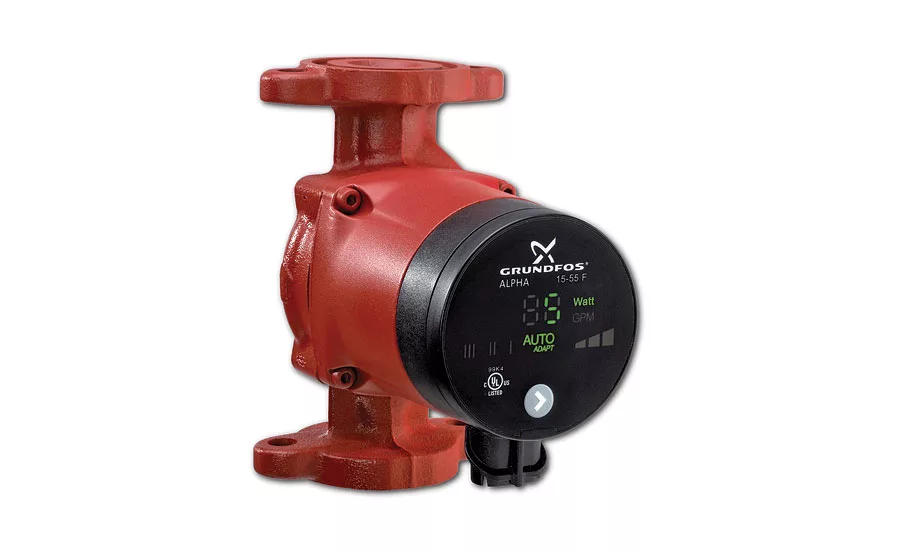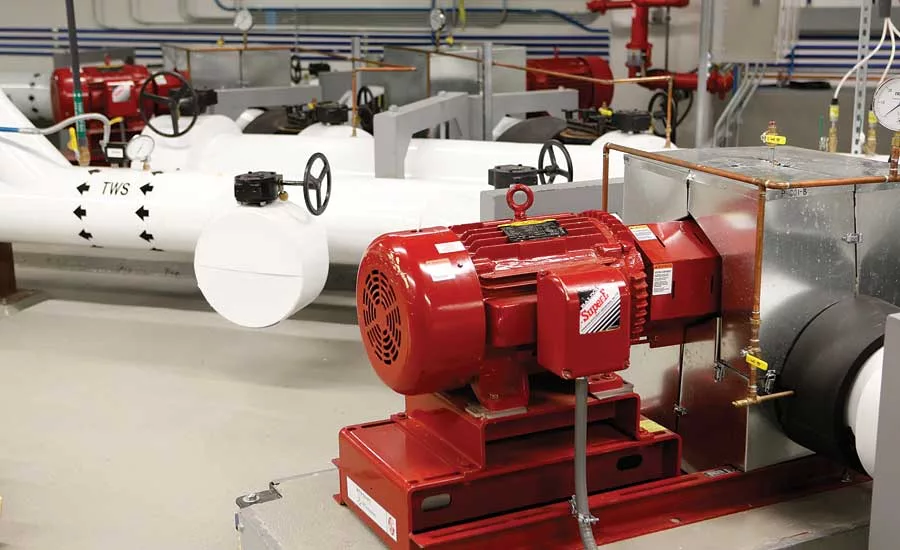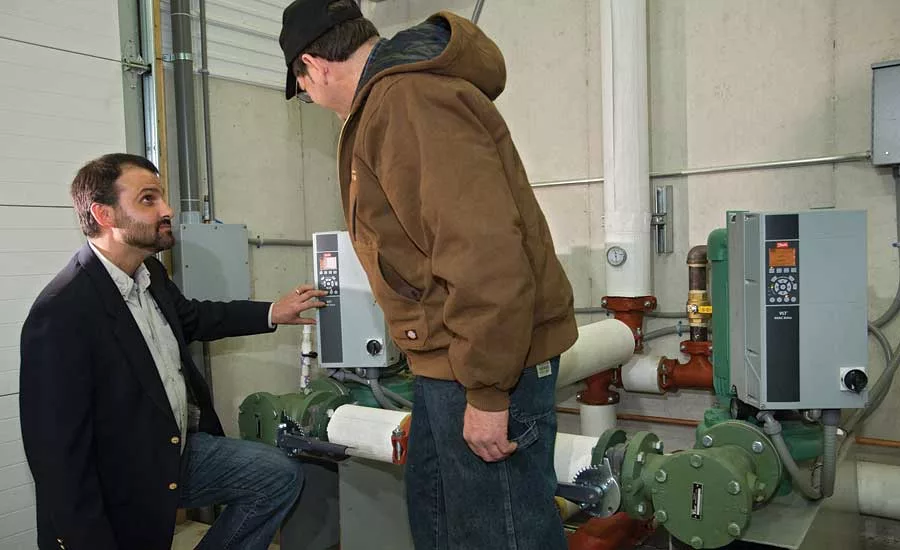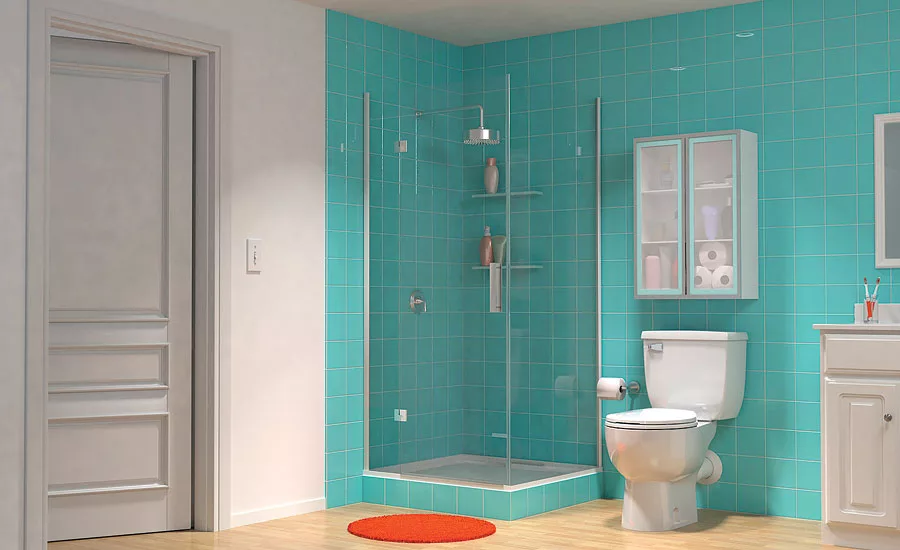Pump manufacturers design with efficiency in mind
Pump it up.

ECM circulators find the lowest possible operating-efficiency point to meet system demand and then continuously adjust that setting to achieve optimal comfort at minimal power consumption — all without direct human intervention. Photo credit: Grundfos

ECM circulators find the lowest possible operating- efficiency point to meet system demand and then continuously adjust that setting to achieve optimal comfort at minimal power consumption — all without direct human intervention. Photo credit: Grundfos

Inside the Energy Systems Integration Facility on the campus of the National Renewable Energy Laboratory in Golden, Colorado, Xylem’s Bell & Gossett e-1510 pumps are among the ultra-efficient products that are helping save an estimated $1 million in annual energy costs. Photo credit: Bell & Gossett

Taco’s SelfSensing pump lines offer do-it-yourself system balancing for both constant-flow central plant applications and variable-flow building distribution applications, and ease of use and setup. Photo credit: Taco Comfort Solutions

The vitreous china toilets (round model pictured) from Saniflo are high-efficiency, meeting the WaterSense labeling criteria of the Environmental Protection Agency. Photo credit: Saniflo
In just the past few years, the U.S. Department of Energy has created and amended numerous minimum efficiency standards for many of the products and components commonly found in plumbing and mechanical systems — including pumps. These regulations have prompted some manufacturers to make adjustments to their product offerings in order to meet and exceed the new rules — and prepare for future standards.
regulations affect pump design
For commercial pumps, DOE announced a final rulemaking in January of 2016 which set, for the first time, minimum bare pump and extended product — pump, motor, and drive — efficiency levels, said Mark Chaffee, vice president of governmental affairs and sustainability, Taco Comfort Solutions.
“By regulating out the bottom 25% of the least-efficient pumps on the market, the new regulations are estimated to reduce electricity consumption by about 30 billion kWh and save end-users up to $1.1 billion over 30 years,” he said. “That’s the carbon equivalent to removing 4.5 million cars from the road for one year, or removing 2.22 million homes from the grid for one year.”
The rule, which goes into effect in 2020, is already affecting manufacturers, who will have spent tens of millions of dollars on research and development to comply.
“That means plenty of new models and new technology will be flowing into the market along with the discontinuation of some old favorites,” Chaffee added.
For Saniflo, there haven’t been as many changes to the types of pumps they employ, though the company is still affected by DOE regulations.
“The UPC and IPC codes continue to be the primary ones that impact us,” Saniflo USA CEO Regis Saragosti said. “Most recently, we had to deal with WaterSense regulations for the toilet.”
Exceeding expectations
As efficiency regulations tighten, consumers are simultaneously demanding better performance out of their systems. And, as pump technology heads toward the intersection of greater energy efficiency and intelligent delivery of comfort, new technologies will be required to meet these demands.
“That will mean a greater use of ECM motor technology, on-board intelligence, and easier integration with building management control systems,” Chaffee said. “Ultimately, all products will need to be compliant by 2020, so Taco preferred to do so proactively. After all, we can’t argue the fact that improving the energy efficiency of buildings is good for the environment and improves our nation’s energy sustainability overall. These concerns are etched pretty deeply at Taco; it’s in our nature. Our own buildings are heated and cooled hydronically – the cornerstone of our LEED certifications. We prefer to lead by example.”
“Xylem’s Bell & Gossett brand began retooling its product lines a number of years ago in anticipation of the DOE regulations for clean-water pumps,” said Mark Handzel, vice president of product regulatory affairs and director of building services marketing for Xylem Inc., Applied Water Systems Division, in the Americas. “The DOE and industry leaders, including those from Xylem, began working on the framework for the new rules in 2011.”
Bell & Gossett’s e-Series line of pumps for HVAC and plumbing applications are designed with cutting-edge computational fluid dynamics technology, which produces dramatic improvements in efficiency, Handzel said. These highly efficient pumps not only use less energy, they contribute to increased system performance and lower life cycle costs as well as longer overall equipment lifetime. These pumps achieve and exceed DOE efficiency targets more than three years in advance of the compliance date.
“In addition, Xylem’s pump test laboratory in Morton Grove, Illinois, has been approved through the Hydraulic Institute Pump Test Lab Program — another important aspect of compliance with the federal regulations,” Handzel added.
“We continue to look at improving the energy efficiency of pumps, circulators, and all systems,” Chaffee added. “We are actively redesigning many product lines to meet or exceed the coming standards. As they become fully revealed, we expect to be comfortably on the front end of the efficiency standards.”
Meanwhile, Saniflo’s pumps have “always been approved” by independent laboratories, though changes were recently made to its toilet bowls to meet the most recent WaterSense regulations, Saragosti said. “We changed our toilet bowls to meet the WaterSense standard of flushing a maximum of 1.28 gallons per flush.”
Current pump trends
In addition to increasing efficiency, a major trend in the pumps market, specifically those pumps used in comfort systems, is the ability to adjust to meet demand.
“In general, the increasing acceptance and application of variable-speed pump solutions has had a large impact on an application’s energy efficiency,” Grundfos Pumps Corp. Business Development Director Kirk Vigil said. “Whether using a separate motor drive or a Grundfos integrated drive motor, customers can tailor consumption to actual demand.
“Energy efficiency for circulators has migrated to North America not because of legislation, but rather because it is the smart and right thing to do,” Vigil continued. “The technology needed to make pumps more energy efficient fosters innovations in design, functionality, and, most importantly, reliability and comfort.
Handzel also highlighted the importance of variable speed capabilities in meeting energy and comfort demands.
“With an ever-greater focus on sustainable and energy-efficient building design, right-sizing the components of a building’s HVAC system provides a significant opportunity to achieve project performance goals,” he said. “Detailed analysis of the building’s heating and cooling loads helps ensure the proper equipment is selected for a system, maximizing efficiency and minimizing operating costs. Using high-efficiency pumps with properly applied variable speed controls will warrant significant energy savings for a given hydronics system.”
With variable speed drives becoming more and more prevalent, there is more interest in retrofitting existing systems to improve efficiency and lower operating costs, Handzel added.
“Awareness of the benefits of a variable pumping system means there is more pressure from end users on system designers to incorporate energy-saving components. This underscores the necessity for specifying engineers to become educated not only on new products and technologies but on how to maximize efficiency through total system design.”
Highly efficient pumps with variable-speed capabilities are also helping commercial buildings achieve LEED Gold and Platinum certification along with net-zero building goals, Chaffee said. And, since pumps are at the heart of hydronic systems, they, too, have been pushed by installers for greater ease of use, efficiency, and integration of controls.
“Of these, and especially in the commercial market, the call for integrated controls has been loud and clear,” Chaffee said. “So Taco, in developing its SelfSensing pump lines, made sure that the technology provided unique benefits, like do-it-yourself system balancing for both constant-flow central plant applications and variable-flow building distribution applications, and ease of use and setup.
“The pumps’ performance and characteristic curves are embedded in the memory of the speed controllers during manufacture,” Chaffee continued. “This data includes power, speed, head, and flow across the flow range of the pump. During operation, the power and speed of the pump are monitored, enabling the controller to establish the hydraulic performance and position in the pump’s head-flow characteristic. These measurements enable the pump to continuously identify the head and flow at any point, providing accurate pressure control without the need for external feedback signals from a sensor.”
“The integration of motors and controls on self-contained systems means the pumps themselves provide a wealth of information about power consumption and other indicators,” Handzel agreed. “The users of the equipment can monitor the pump for trends, which might indicate the pump is wearing out or that a bearing is going bad. Pump operators can then schedule planned outages for maintenance rather than being surprised by a pump’s failure.
“Engineers can achieve optimum pump system performance by considering the motor, pump, and drive as one unit instead of individual components reacting to system requirements,” he continued. “They can also take into account the payback in energy savings with these newer control systems when designing an HVAC system.”
Chaffee said ease of installation and use are going to continue to improve as efficiency improves.
“Taco’s OneTouch ProBalance system permits automatic balancing of SelfSensing pumps — and by extension, the entire hydronic system — with one click of the mouse, providing full plug n’ play connection with all major building automation systems. When combined with our iWorX control system, the advantages are multiplied. For building owners, this means custom integration with dramatically reduced installed cost, greater system intelligence, and continuous monitoring and control of system performance, and energy management for the life of the building.”
Vigil said grinder pumps are becoming standard in many sewage systems due to their advantages.
“We like to believe that Saniflo was part of this change,” he said. “We have noticed that most manufacturers don’t push their sewage ejector pumps anymore, instead trying to replace them with grinder pumps. Furthermore, the above-floor plumbing introduced by Saniflo almost 20 years ago has become standard for many contractors, as well.”
What’s next?
As end users and federal and state regulatory bodies continue to demand pumps and pump systems that are more efficient, easier to install, and user-friendly, manufacturers will continue to rise to the occasion.
“As all segments of the building industry move toward the 2030 goal of net-zero-energy buildings — buildings that produce as much renewable energy as they consume on an annual basis — HVAC system design is at the forefront of these efforts,” Handzel said. He added that government policies designed to reduce greenhouse gasses and carbon emissions have resulted in rising electricity costs and a shift from coal to other forms of energy, such as solar power and natural gas, creating a growing focus on energy saved in order to reduce the need for additional power generation.
“These policies present both an opportunity and a necessity to manage energy savings through efficient HVAC system design,” Handzel said. “With ultra-efficient pumps, advanced controls, and integrated design, environmentally conscious choices can start today to improve energy efficiency and reduce electricity consumption.”
But, technology has its limits, and some top-of-the-line products are already nearing that max-tech threshold. Still, there are other ways in which these components and systems can improve.
“I believe we will see more market transition from old-style motors to ECM or energy-efficient technology,” Vigil said. “However, I believe we will see advances in how circulators communicate and integrate with other system components. I think we will see more integration with building management systems as well as home management systems. The trend toward ‘works with’ is only going to get bigger.”
“We hope that the pump industry will continue its path toward the new generation of grinder systems provided by Saniflo,” Saragosti said. “Above-floor plumbing is a worldwide type of installation, and we hope to see this market expand further in the U.S.”
Upcoming changes in the market mean installation changes, increased education and training, selling differently to customers, cost increases, and more for contractors, Chaffee said.
“It’s clear that installers will not be able to buy some pumps in the future, and most of the pumps remaining on the market will be changed in some way to make them more energy efficient,” he said. “Contractors will always have inline or vertical pumps, though operational efficiencies will improve, drives will become more prevalent, and the cost for all this efficient technology will inevitably increase.”
Additionally, improvements to labeling are helping to ensure informed purchasing so that the right pumps and pump systems are chosen for the right applications.
“[It’s] not unlike consumer labeling on dishwashers or air conditioning equipment,” Chaffee said. “In 2017, The Hydraulic Institute will roll out an industry-backed voluntary commercial-pump-labeling program. It will act as a yardstick, with energy ratings that will be applicable to all pumps covered under the DOE’s commercial and industrial pump rulemaking. The labelling program will also be a major component of proposed pump incentive programs offered by state efficiency and utility programs.”
In the end, energy saved translates to dollars saved, which means energy efficiency will only continue to be a priority for both manufacturers and end users, Chaffee added.
“With almost $9 billion being spent annually on energy efficiency programs nationwide, we should see a greater share of that money flowing into incentivizing the installation of higher-efficiency pumping products in the years to come.”
This article was originally titled “Pump it up” in the January 2017 print edition of Plumbing & Mechanical.
Looking for a reprint of this article?
From high-res PDFs to custom plaques, order your copy today!








